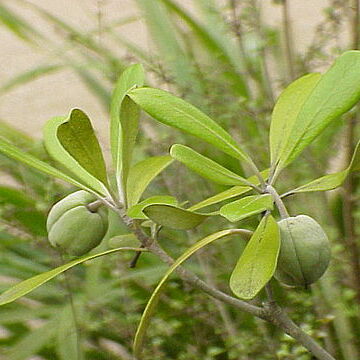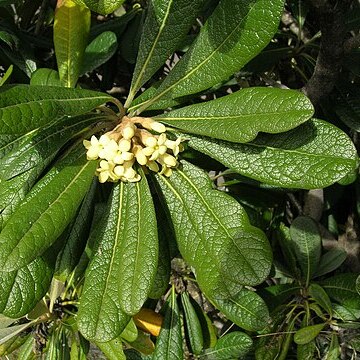Stamens 5, alternate with petals, free or with somewhat connivent filaments; anthers dithecous, introrse, opening by slits or pores. Ovary superior, sessile or shortly stipitate, paracarpous, with 2–5 carpels and parietal placentas, usually unilocular but sometimes 2–5-locular by central contact of placentas; style simple with capitate or somewhat lobed stigma. Fruit a berry or a capsule with generally entire valves. Seeds without an aril but often covered by a viscid resin, rarely dry and winged; testa thin and smooth; endosperm copious and horny; embryo minute. Evergreen trees, shrubs or climbers with resin-ducts in the bark, rarely spiny. Leaves alternate, often crowded at the ends of the branches, simple, entire, dentate or lobed, ± leathery. Stipules absent. Flowers few to many in terminal and/or axillary panicles or cymes, sometimes in clusters on the old wood or solitary in the axils, regular or rarely slightly irregular, hypogynous, bisexual or functionally (rarely morphologically) unisexual. Sepals 5, free and imbricate at least in bud, or somewhat connate. Petals 5, imbricate in bud, generally free, rarely with slightly connivent claws
Trees or shrubs, evergreen, glabrous or pubescent, occasionally spiny. Leaves alternate, occasionally opposite, estipulate; leaf blade mostly leathery, margin entire, rarely dentate or lobed. Inflorescences umbellate, corymbose, paniculate, or a solitary flower, bracteate and bracteolate. Flowers usually bisexual, sometimes polygamous, actinomorphic, rarely zygomorphic, usually 5-merous (except ovary). Sepals usually free or slightly connate. Petals free or connate, white, yellow, blue, or red. Stamens opposite sepals; filament filiform; anther basifixed or dorsifixed, 2-loculed, dehiscing longitudinally or by pores. Ovary superior, of 2 or 3(–5) carpels, usually 1-loculed or incompletely 2–5-loculed; ovules numerous, anatropous; placentation parietal, axile, or basilar. Style short, simple or 2–5-lobed, persistent or deciduous. Fruit a capsule dehiscing by adaxial suture, or a berry. Seeds numerous; testa thin; endosperm well developed; embryo small.
Ovary sessile or shortly stipitate, paracarpous, with 2–5 carpels and parietal placentas, usually 1-locular, or, less often, 2–5-locular by central contact of the placentas; style simple, stigma capitate or somewhat lobed; ovules 2-several in 2 rows, anatropous, horizontal, with one integument
Ovary 1-celled with parietal placentas or 2–5-celled and the placentas meeting in the middle, superior, sessile or shortly stipitate; style simple, terminal; ovules numerous
Leaves alternate, often crowded at the ends of the branches, simple, evergreen and ± leathery, entire or rarely dentate or lobed, without stipules
Seeds without an aril but often covered by a viscid resin, rarely dry and winged, with a smooth testa, a hard endosperm and a very minute embryo
Inflorescences cymose or paniculate, terminal and/or axillary, rarely flowers in clusters on the old wood or solitary, terminal and/or axillary
Flowers actinomorphic or somewhat irregular, hypogynous, bisexual or functionally (rarely morphologically) unisexual
Petals 5, free or with claws slightly connivent, usually with spreading or revolute blades, imbricate in bud
Stamens 5, hypogynous, free, alternate with the petals; anthers 2-celled, opening lengthwise
Fruit a loculicidal capsule with the placentas in the middle of the valves, or indehiscent
Stamens 5, free, with 2-thecous introrse anthers opening by slits, rarely by apical pores
Woody plants, trees, shrubs or climbers with resin-ducts in the bark, rarely spiny
Petals 5, longer than the sepals, imbricate, free or united at the base
Fruit a berry or a capsule with entire, rarely split valves
Sepals 5, free or ± connate, sometimes imbricate
Seeds with hard endosperm and minute embryo
Leaves alternate, simple; stipules absent
Sepals 5, imbricate, free or nearly so
Flowers actinomorphic, hermaphrodite
Trees or shrubs


